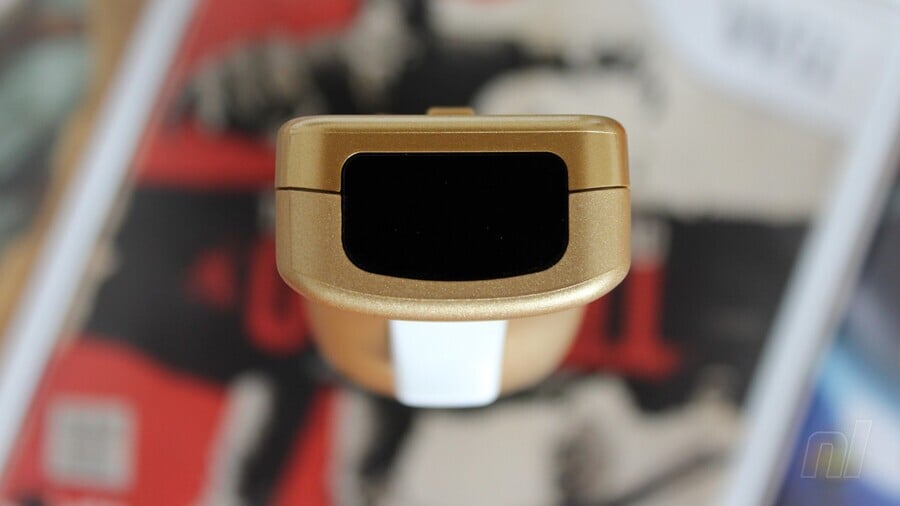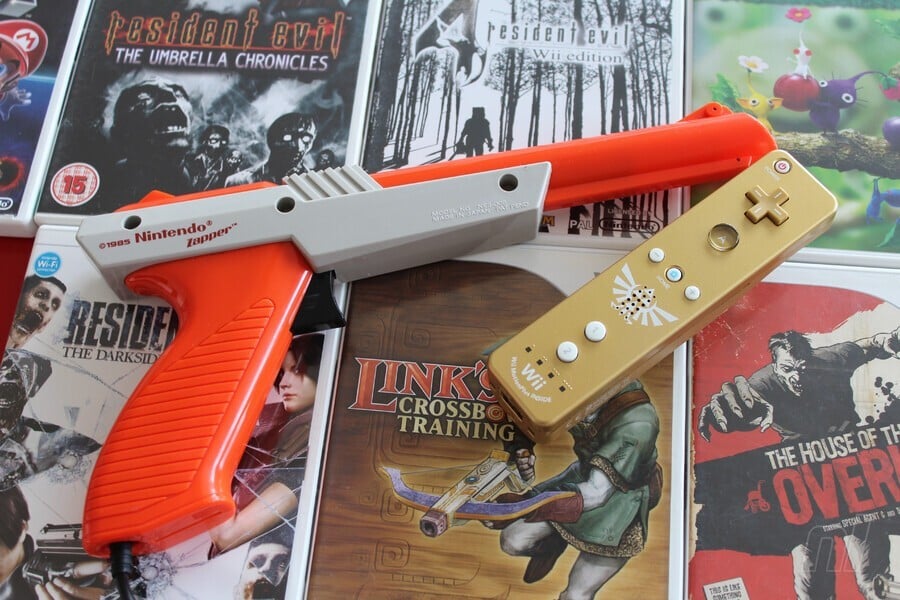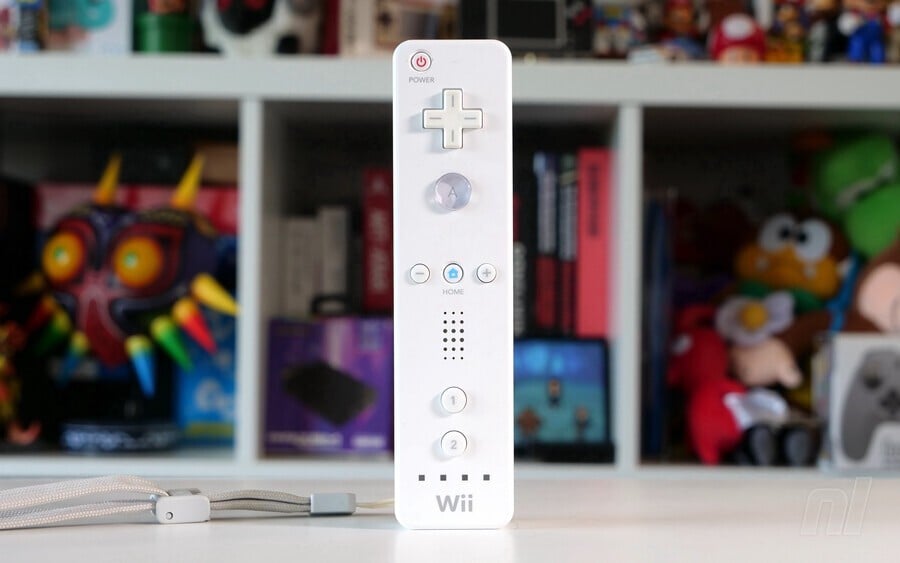
The Sensor Bar. Flimsy little plastic box with the world’s longest, spindliest cable. An irritation to every Wii owner who has ever had to move their console. What was it good for?
There’s not a lot to the Sensor Bar. A little device that emits some infrared light. If the Wii Remote is pointed at one, it recognises that’s where the TV is. It’s not high-tech. Famously, its functionality can be replicated by two candles. Cheap, cheerful, reliable.
The Wii’s motion controls weren’t always implemented in particularly complementary ways. Anyone who’s ever had to pull off a special move by aggressively shaking the remote, or perform intricate aerial manoeuvres via tilting a controller will gladly tell you that. But did anyone have a problem with pointing?
The concept of pointing and clicking dates back to some of the earliest electronic games. Not just clicking a mouse in adventure and strategy games, but further back to clicking a trigger in the early light gun games and the electronic shooting ranges that inspired them. Over a decade before introducing the NES Zapper, Nintendo had already operated businesses for electronic clay pigeon shooting in abandoned bowling alleys and later brought out a home equivalent that projected flying ducks on players’ walls. Pointing and shooting are more deeply engrained into Nintendo’s DNA than the D-Pad, representing some of their first work with electronic entertainment.
Though the limited commercial impact of the Super Scope and concerns about representing itself as a family-friendly brand may have put off Nintendo from dabbling with the technology for around a decade and a half afterwards, light guns found massive success in arcades at the time, through games from such developers as Namco, Sega, Midway, Taito, and Konami.
The Wii’s marketing focus was all on the accelerometer, but the secret sauce was in the infrared sensor.
A diverse library of titles steadily built itself on the technology, from the pioneering 3D design sensibilities found in games like Virtua Cop and Time Crisis, to the live-action laserdisc games Mad Dog McCree and Who Shot Johnny Rock, to later technological experiments like Silent Scope and Police 911. It’s a critically important part of gaming history, and one that was soon forgotten as arcades died out and consumers swapped their old CRTs for HD Ready TVs.
The Wii’s marketing focus was all on the accelerometer, getting people up out of their seats to bowl, dance and generally gesticulate wildly, but the secret sauce was in the infrared sensor. It’s what made navigating the main menu so intuitive, crossbow aiming so quick and satisfying in Twilight Princess (not to mention Link’s Crossbow Training), and brought whole new genres to the console. Giving the controller a sense of where the player’s display was allowed for a whole new range of intricate actions, and even hard-nosed gaming veterans became believers in the technology when they saw its application in Metroid Prime Trilogy and Resident Evil 4: Wii Edition.
Excitement for the Wii Remote was so high that Nintendo rereleased a range of GameCube titles as ‘New Play Control’ versions. Success of these titles was varied, but the generally agreed highlights of the series were the new versions of Pikmin 1 and 2, which used pointer controls to aim your Pikmin — a feature so well received that it was featured heavily in the original Wii U version of Pikmin 3.
Pointer controls also encouraged ports of older titles like light gun games, The House of the Dead 2 & 3 Return, Ghost Squad, and Mad Dog McCree, and point-and-click games like Broken Sword and Telltale Games’ LucasArts revivals in the Monkey Island and Sam & Max series. Even games that were designed with a touchscreen in mind, like the DS’s Another Code and Trauma Center, would receive pointer-centric sequels on the Wii. Genres that hadn’t been thought of as viable home console releases for years finally found a home again. The technology even led Nintendo to re-releasing its most iconic light gun game, Duck Hunt, on the Wii U Virtual Console with Wii Remote support.
Flash forward to 2017. The Wii U — which, let’s not forget, had a ‘sensor bar’ built into the GamePad itself to enable off-TV pointer-based play and compatibility with the Wii’s library — is regarded as a commercial failure and a mark against Nintendo’s reputation. The Wii is now deeply unfashionable, and the company wants to distance itself from the branding. The Switch would not feature a Sensor Bar and IR functionality was reduced to an infrared sensor in the bottom of the right Joy-Con.

Haven’t we lost something valuable there? The expanding popularity of the Switch and the diversity of titles on the eShop has led to all sorts of quirky games finding niche audiences. Genres that had been thought of as unmarketable in the 2010s are now thriving. Nintendo has brought first-party ports of games to the console that once featured IR pointer support. Pikmin 3 Deluxe and Super Mario 3D All-Stars’ version of Galaxy attempt to replicate the intuitive, reliable controls of their original releases via the Joy-Con’s gyroscope, but without the sensor bar they lack that real-world reference point to maintain accurate tracking. Skyward Sword HD also suffered from the loss of the sensor bar to help keep its gyro-based sword positioning in check.
You need only compare the pointing of the original World of Goo to the Switch port to get a sense of just how much more reliable the infrared tech is. Unless a bright light source interferes with your sensor bar, of course, but we’re told real gamers play only in dank, darkened basements, so they shouldn’t be troubled by inconveniences like twinkling Christmas tree decorations. Or, you know, sunlight.

There are downsides to IR, then, but they simply don’t outweigh the benefits. Gyro-based cursors inevitably drift, lack accuracy compared to the IR equivalent, and need to be reset and recalibrated frequently. Gyro controls can work well, particularly when they’re supplemented by analogue aiming, such as in Splatoon or Metroid Prime Remastered, but your Switch doesn’t know where you’re pointing your Joy-Con or where your TV is. Gyro aiming is a compromise.
Maybe there’s a future for pointer controls, though, IR or otherwise. Gyro advocates have been so persistent that even Sony is starting to support the technology in big titles like The Last of Us Part I and God of War Ragnarök. There is also a glimmer of hope for light gun fans with the PC release of The House of the Dead Remake receiving support for the Sinden Light Gun, which works with modern televisions, unlike your NES Zapper and other traditional light guns. Players have discovered that the Switch Joy-Con can function as a stand-in Sensor Bar, so while Nintendo abandoned the bar itself, it hasn’t totally forgotten IR tech on Switch — it’s just limited to novelty ‘cameo’ functions in the Labo series, Brain Training, 1-2-Switch, and a handful of other titles.
Nintendo has re-released old controllers in the past, with Nintendo Switch Online subscribers able to pick up Bluetooth versions of the NES, SNES, and N64 pads to use on their Switch. We still don’t know exactly how Pikmin 4 controls on Switch, but we do miss the accuracy of old-fashioned IR pointing. Perhaps it’s up to us to let Nintendo know we still care about this stuff. Some of us may still have the bitter taste of terms like “waggle” and “shovelware” in our mouths, but maybe we just need to… recalibrate a little.

Let us know below if you miss the precision and spindly cable of the sensor bar/Wiimote combo, and the games you enjoyed most with them.
>>> Read full article>>>
Copyright for syndicated content belongs to the linked Source : Nintendo Life – https://www.nintendolife.com/features/the-one-thing-wii-did-much-better-than-switch




















![Forest ecology cannot be reduced to arithmetic, says M.I. Varghese [Interview] – Mongabay-India](https://earth-news.info/wp-content/uploads/2025/12/328946-forest-ecology-cannot-be-reduced-to-arithmetic-says-mi-varghese-interview-mongabay-india-350x250.jpg)










![Forest ecology cannot be reduced to arithmetic, says M.I. Varghese [Interview] – Mongabay-India](https://earth-news.info/wp-content/uploads/2025/12/328946-forest-ecology-cannot-be-reduced-to-arithmetic-says-mi-varghese-interview-mongabay-india-120x86.jpg)